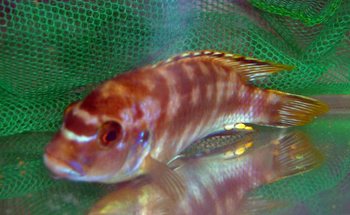Metriaclima sp. "lanisticola north"

Above: A male Metriaclima sp. "lanisticola north". Photo by Sue Ewald.
Etymology:
Genus- Metri= average (Latin), clima= slope (Latin).
Species- lanisticola= Named after the Lanistes genus of snails, the type of snail shell that Metriaclima lanisticola lives in, north= found in northern Lake Malawi.
Intro:
Metriaclima sp. "lanisticola north" is an undescribed Lake Malawi mouth brooder. This fish is very similar to the described fish Metriaclima lanisticola but differs in that it has a submarginal band in its dorsal. This fish is a shell dwelling mbuna like the Metriaclima lanisticola.
For many years Metriaclima lanisticola was considered to be a synonym of Pseudotropheus livingstonii. It is in fact a valid species (Konings, 2007). It turns out that almost all fish in the hobby that were called Pseudotropheus livingstonii were in fact Metriaclima lanisticola and the true Pseudotropheus livinstonii were labeled as a Pseudotropheus elegans. Konings in the October, 2010 issue of Cichlid News Magazine has stated that the tue Pseudotropheus elegans has been refound and is the fish commonly sold in the hobby as Pseudotropheus sp. "acei". Metriaclima sp. "lanisticola north" was found to be very similar to Metriaclima lanisticola, but different enough to question whether or not it is a different species or not.
Distribution:
Metriaclima sp. "lanisticola north" is found throughout the north of Lake Malawi over open sandy areas.
Size, Maturity, and Sexual Dimorphism:
Size: Males- 2.75 inches, Females- 2 inches
Maturity: 1.75 inches
Sexual Dimorphism: Difficult. Males are larger than females and will have more yellow and a little blue.
Care:
Metriaclima sp. "lanisticola north" is easy to care for. You could have a group of 4-5 in a 40 breeder easily due to this fish's small size. I would not recommend using shells in the tank, but rather terra cotta caves with a tight opening, which allows the fish more room and less of a chance of getting stuck.
I found the males of this species to be non-aggressive in behavior towards females, but will quarrel with any other male in the tank. You should put as many territories as you can put in the tank and numerous hiding spot to cut down on aggression. I did not find this fish to harass other species. They seem to mix well with other mbuna and haps.
Diet:
In the wild this fish forages around for algae. I had no issues feeding this fish and they enjoyed a diet of HBH graze, spectrum, and tetra cichlid flakes.
Breeding:
This fish was not very hard to spawn. Mine spawned inside a terra cotta cave. Typical for mbuna, the male displays and the fish spawn. The females are great holders. Females hold up to 14 days, a very short period for an mbuna! The fry are large and grow fast. Spawns are small, most likely from the size of the small size of the parents and the large size of the eggs. The fry were easy to feed and were taking crushed flake from the start.
Conclusion:
Metriaclima sp. "lanisticola north" is a very cool fish to keep. Good luck finding it. They are rarely around and your local pet shop probably doesn't have them. If you do see them and you are an mbuna lover or like small cichlids, buy them. The stocky appearence and behavior demonstrated by this species make it an interesting aquarium subject.
References:
- Konings, A. (2007) Malawi cichlids in their natural habitat. 4th ed., Cichlid Press, El Paso, Texas, 424 pp.
